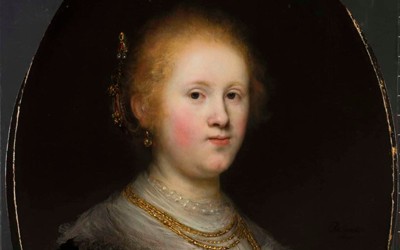New conservation techniques revealed the painting’s actual artist.
For five decades, a museum in eastern Pennsylvania believed it owned a painting that was made in the studio of Rembrandt van Rijn. After sending it out for routine maintenance, they learned that the 388-year-old work was in fact made by the Dutch Golden Age artist himself.
Like many Old Master canvases, layers of overpaint and varnish obscured Rembrandt’s oil-on-oak painting Portrait of a Young Lady (1632), which has lived in the collection of the Allentown Art Museum since 1961. But new state-of-the-art conservation and imaging techniques have allowed researchers to remove these layers, uncovering the artist’s sure hand below.
“We can see it with new eyes now,” Elaine Mehalakes, the museum’s vice president of curatorial affairs, tells Artnet News. “There’s a glow that was obscured before. And it has a weight that’s been brought to it in terms of the scholarly attention that it’s getting.”
Portrait of a Young Lady was donated to the museum by the Kress Foundation, an organization formed around the world-class collection of Renaissance artworks amassed by the Allentown-born department store magnate Samuel Kress. At the time, it was attributed to Rembrandt. But a decade later, a Netherlands-based initiative dedicated to the study of the Dutch painter declared it to have been merely made in the artist’s Amsterdam workshop, not by the artist himself.
This wasn’t an uncommon occurrence with the artist’s work, says Mehalakes, noting that “Rembrandt attributions have been very volatile over the years.” There have been, at various times, as many as 600 paintings attributed to the artist, or as few as 200, the curator says.
Formed in 1929, the Kress Foundation has donated Renaissance masterpieces to regional museums throughout the US. It oversees the conservation of these artworks—free of charge to the institutions that now own them—through a dedicated lab at New York University.
Beginning in 2018, researchers performed a variety of newfangled tests on the Allentown Museum’s painting, many of which had never been applied to it before, including infrared reflectography, scanning electron microscopy, and cross-section evaluation. They were able to peer into the “past of the painting,” as Mehalakes puts it, and identify Rembrandt’s brushstrokes.
For Mehalakes, the discovery was a reminder that the history of art is not a closed book. “This single object in our collection has this incredibly rich and complicated history and for all we know there could be stories like that among other artworks,” she says. “It’s very exciting.”
The newly restored painting will go on view at the Allentown Art Museum beginning June 7, 2020.
